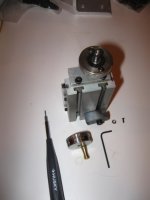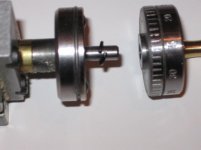I finally have some time to play around with my mid size cuesmith that I purchased from Chris last year. I am trying to learn as I go and experiment with things. I've got a couple of beginners questions 
Hope others who might be starting to learn like me would find this thread useful too, as I plan to update this thread and keep track as I learn..
So to start:
Why do people use different sized revolving centers? I've got a small live centre that I cut into the back of and drilled a hole through to match the butt of the drill chuck that came with the mid size. Now I can attach the drill handle to it and fix and release a piece of wood between centers easily. Do I need a 60 degree center for thicker pieces of wood? why?
One more: The cross slide that holds the toolbit has a little wheel with a handle to move the cutting bit across to cut the wood. It is very loose and sometimes if i release the handle in a position like this: -o the handle turns/drops down by its own weight and moves the cutting bit deeper into a piece of wood. I was finishing a ferrule the other day and ruined it like that I can't seem to figure out how to tighten the movement of the wheel.
I can't seem to figure out how to tighten the movement of the wheel.
Sorry if I have not used the correct terminology for some of the things. Hope you can help.
Hope others who might be starting to learn like me would find this thread useful too, as I plan to update this thread and keep track as I learn..
So to start:
Why do people use different sized revolving centers? I've got a small live centre that I cut into the back of and drilled a hole through to match the butt of the drill chuck that came with the mid size. Now I can attach the drill handle to it and fix and release a piece of wood between centers easily. Do I need a 60 degree center for thicker pieces of wood? why?
One more: The cross slide that holds the toolbit has a little wheel with a handle to move the cutting bit across to cut the wood. It is very loose and sometimes if i release the handle in a position like this: -o the handle turns/drops down by its own weight and moves the cutting bit deeper into a piece of wood. I was finishing a ferrule the other day and ruined it like that
Sorry if I have not used the correct terminology for some of the things. Hope you can help.



